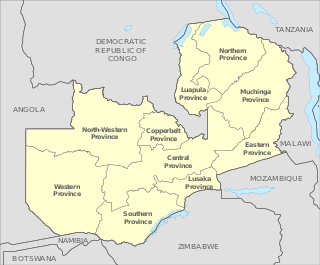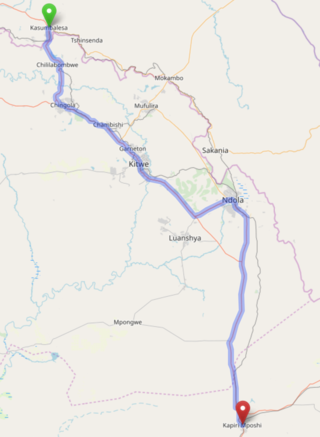
Zambia is divided into 10 provinces for administrative purposes. Each province is headed by a minister appointed by the President and there are ministries of central government for each province. The administrative head of each province is the Permanent Secretary, appointed by the President. There are Deputy Permanent Secretary, heads of government departments and civil servants at the provincial level.

Ndola is the third largest city in Zambia and third in terms of size and population, with a population of 475,194, after the capital, Lusaka, and Kitwe, and the second largest in terms of infrastructure development after Lusaka. It is the industrial and commercial center of the Copperbelt, Zambia's copper-mining region, and capital of Copperbelt Province. It lies just 10 kilometres (6.2 mi) from the border with DR Congo. It is also home to Zambia's first modern stadium, the Levy Mwanawasa Stadium.

Kitwe is the third largest city in terms of infrastructure development and second largest city in terms of size and population in Zambia. With a population of 517,543 Kitwe is one of the most developed commercial and industrial areas in the nation, alongside Ndola and Lusaka. It has a complex of mines on its north-western and western edges.

The ten provinces of Zambia are divided into a total of 116 districts as of 2018.

The following outline is provided as an overview of and topical guide to Zambia:
Zambia, officially known as the Republic of Zambia, is a landlocked country in Southern Africa. The neighbouring countries are the Democratic Republic of the Congo to the north, Tanzania to the north-east, Malawi to the east, Mozambique, Zimbabwe, Botswana, and Namibia to the south, and Angola to the west. The capital city is Lusaka, located in the southeast of the country. The population is concentrated mainly around the capital and the Copperbelt to the northwest.

Kingsmead School (KS) is a coeducational state school in Wiveliscombe, Somerset, England, serving the north-west of Taunton Deane district. It had 804 pupils between the ages of 11 and 16 years in 2013.
Northrise University is a private, Christ-Centered University in Ndola, Zambia. It was founded in 2003 by Dr. Moffat Zimba and Mrs. Doreen Zimba.

Cecily's Fund is a UK-based charity that enables impoverished children to go to school in Zambia, with a particular focus on those orphaned or made vulnerable by AIDS.

Parklands High School is a small high school in the southern part of Lusaka in Chilanga constituency of Zambia. The school's motto is "Narrow path is the way" which is literally based on Bible principles. The school is about 12 kilometers away from the heart of Lusaka, about 2 kilometers away from the well known Munda Wanga Zoo, and about 4 kilometers away from the Lafarge factory. The school offers secondary school education to people who live in Chilanga and nearby.
Mukuba University is a public university in Garneton (Itimpi), Kitwe, Zambia. The Mukuba University, formerly Copperbelt Secondary Teachers College (COSETCO), was established in 1974 by the Ministry of Education to train Teachers of Science for deployment in secondary schools around the country. Since its inception, COSETCO as an institution trained teachers of mathematics, natural sciences, and home economics.
Rockview University is privately owned and operated university located in Lusaka, Zambia. It is one of the fastest growing universities in Zambia and keeps seeing an exponential increase in the number of admissions each and every year. Every year, Rockview embarks on a country-wide interview program in which it awards bursaries to school leavers as well as those in service and would like to upgrade their studies. Lady Justice Lombe Chibesa is currently serving as the university chancellor.
The Higher Education Authority (HEA) of Zambia was established under the Higher Education Act No. 4 of 2013 in order to provide quality assurance, regulation of private and public higher education institutions and registration of private higher education institutions.
Henry Joe Sakala is a Zambian actor, writer, producer and director known for his leading role in a short film Guns and Rings and writer of the screenplay for the 2009 film, Reflection of Sadness.

The T3 is a Trunk Road in Zambia. The road runs from Kapiri Mposhi via Ndola, Kitwe and Chingola to Kasumbalesa on the border with DR Congo. The entire route is a toll road.
The M16 is a short 14-kilometre road in Kalulushi District, Copperbelt Province, Zambia that connects Kalulushi with Sabina.

Aaron Dzimbanhete Mujajati, is a Zambian physician, author and entrepreneur. Mujajati holds a Masters of Business Administration in Healthcare Management from the University of Lusaka and a Masters of Medicine in Internal Medicine from the University of Zambia.











